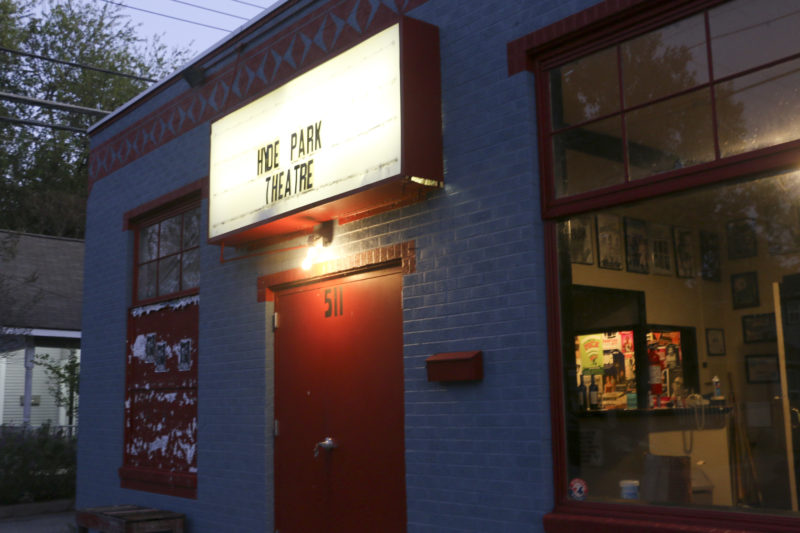Austin Theater Groups Look to Post-Pandemic Future
By Veronica Apodaca
Reporting Texas

The Hyde Park Theatre reopened with its first in-person show on Nov. 12, 2021 in Austin, Texas. The venue relied on virtual performances since the start of the COVID-19 pandemic last year. Veronica Apodaca/Reporting Texas
Austin’s vibrant live-theater scene — the city has at least 85 professional and community theater companies — has become a vital part of the city’s arts landscape. With the companies’ work becoming such a large part of Austin’s culture over the years, city residents appreciate what it contributes to their lives.
“We talk about physical stuff, but there’s a spiritual component and a value and a sustenance that you get from (theater),” said Adrian Villegas, cofounder of ATX Stage Diversity and director of The Latino Comedy Project.
When the spread of COVID-19 in the spring of 2020 restricted large gatherings, live theater felt the effects deeply. Theater groups were suddenly left without ticket revenue, a main source of funding that allows them to continue their work, as well as the basic necessity of having a place to gather for rehearsals and performances. Now, as Austin businesses reopen and restrictions are being lifted, Austin’s live theater community is working to bring their unique form of art back to the city.
Many of the theater groups that survived did so with financial help from the U.S. Small Business Administration’s Shuttered Venue Operators Grant, which awarded over $16 billion in grants nationally.

Ken Webster, artistic director of the Hyde Park Theatre, performs in “My Seasons with the Astros, Expos, and Phillies,” the first in-person show at the venue since the COVID-19 pandemic hit in 2020. Veronica Apodaca/Reporting Texas
“We got one of the federal government SVOGs, and that’s going to help us get through 2021 and, I believe, 2022,” Ken Webster, the artistic director of Hyde Park Theatre, said.
Hyde Park received close to $110,000 from the SVOG, according to data from the U.S. Small Business Administration.
During the pandemic, theater groups also embraced virtual theater, using online streaming as a way to continue working on and presenting productions through uploads of virtual performances, live streams of performances and Zoom readings even when live theatre was not an option.
“We were able to do more things with the online stuff,” Webster said. “We were able to employ quite a few actors, and since what we were doing didn’t require weeks and weeks of rehearsal in-person, it allowed us to do more projects.”
The virtual projects that Hyde Park Theatre took on during 2020 included both visual and audio performances of plays. The shows were free to watch, with audiences having the option to donate to the theater.
For some theaters however, the effects of the pandemic were noticeably detrimental to their work.

Jerseys from “My Seasons with the Astros, Expos, and Phillies” line seats on the opening night of the show at the Hyde Park Theatre in Austin, Texas, on Nov. 12, 2021. Local theater groups collaborated to overcome challenges that came with the pandemic which exacerbated existing hardships. Veronica Apodaca/Reporting Texas.
Prior to the pandemic, gentrification was already making it more difficult for theater groups to find affordable spaces, and the pandemic exacerbated the problem, Villegas said. “(It’s) doing a lot of damage.”
As theaters were struggling due to the financial hardships that came with the pandemic, the city’s theater artists collaborated to create ATX Theatre, a hub for most of the city’s theater companies to promote their work and engage with each other. ATX Theatre’s website contains information on the companies and the shows currently being staged by them.
“(ATX Theatre) is a lot of our theater companies getting together and realizing that we are not in competition with one another and that if we help each other, we’re all going to grow,” said Lisa Scheps, one of the artistic directors of Ground Floor Theatre.
With social distancing restrictions beginning to ease for businesses in Austin, theater groups are exploring how this will apply to their work. Hyde Park Theatre is making the shift back to live performances in December with one-person shows and a limit of 50 audience members in Hyde Park’s 65-seat black box theater.
Patrons of live productions are also looking forward to seeing performances in person again. “The experience of listening to music in a concert hall is very different from listening to it on your laptop,” said Clay Hunn, who frequently attends the Austin Symphony and the Austin Opera, as well as performances at the University of Texas Butler School of Music.
As the city contends with shifting social distancing requirements, as well as the Omicron variant of COVID-19, artists and audiences are adjusting to Austin’s changed theater landscape.
“A lot of stuff has changed forever,” Scheps said. “I do, however, believe that theater and the essence of theater, where people sit in an audience shoulder to shoulder with others, sharing energy with the entertainers onstage, will not go away.”